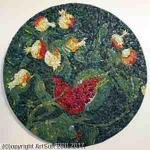Piero Gilardi
Piero Gilardi
Born: 1942
Biography:
Piero Gilardi is a visual artist. Born in Italy from a Swiss family, he studied at the Liceo Artistico in Turin. In an interview with LeGrace G. Benson, Gilardi stated that his personal encounter with artist Michelangelo Pistoletto and others helped him in the development of his own artwork (in parallel with that of American Pop Art). While trying to comprehend the cybernetic idea of feedback and the scientific rational behind man's mental synthesis, his perspective on reality changed; he then focused on the fluxus and relationship of things around him.
A catalytic figure in the Arte Povera movement, concentrated in Turin in the late 1960s, Gilardi's utopian and unselfish dedication to connecting neo-avant garde artists across Western Europe and North America made him one of the most influential artistic figures of the period, albeit not the most famous. He became known in the international scene and witnessed the impact of Pop Art Europe. Itinerant artist, theorist, and organizer, he contributed to the birth of Arte Povera, especially working to establish relationships with other similar initiatives that occurred simultaneously outside Italy, supporting the work artists such as Richard Long and Jan Dibbets, introducing the one of Bruce Nauman and Eva Hesse in Europe.
His uncompromising commitment in favor of closer ties between art and life pushed for action in the fields of psychiatry and anthropology; Gilardi experimented with collective forms of political theater, workshops, and activist struggles with the workers of Fiat and against the implementing of TAV (Treni Alta Velocità: High Speed Trains) in the years 1970–80.
During the 2000s, Gilardi initiated the outdoor project "Park of Living Art" in Turin, that welcomed artists ( Dominique Gonzalez-Foerster, Gilles Clément, Almarcegui Lara, Michel Blazy ...) but also scientists and especially the public, invited to participate directly.Piero Gilardi appears as an iconic figure of developments in art and society over the past five decades; his work and theoretical research can always assess the potential for art to be effective in the real.
In 1963 he made his debut with an exhibition of Neodadaist Macchine per il Futuro at Galleria L'Immagine of Turin.He gained fame with the nature Carpets in 1965 : these are works made of polyurethane, which reproduce in a very realistic style and fragments of natural environment for recreational purposes, but also to report to a style of life which, with the passage of time becomes more and more artificial (Greto of stream, Gallery of Modern Art, Cagliari). These rugs were exposed to Hamburg, Amsterdam, Brussels, Cologne, Milan, New York City, and Paris. From 1968 Gilardi stopped the production of works to participate in the theoretical development of new artistic trends: Arte Povera, Land Art and Antiform, participating in the years 1967 – 1968 as a contributor to the realization of the first two international shows of the new trend of Stedelijk Museum Amsterdam such as the Kunsthalle in Bern (Switzerland). The Stedelijk Museum displays date, in the section dedicated to the history of the museum, part of the correspondence between Gilardi and Wim Beeren, one of the curators of the museum.
From 1968 and for all the seventies to his artistic activity is accompanied by the formation of political activism in the so-called New Left (or far left), covering the artistic movements of the collective creativity and spontaneous, and working in various social environments, where it offers its contribution in the animation's cultural base. Lives creative experiences not only in Italy but also in Nicaragua, in various countries of Africa and in the territories of Native Americans in the United States of America .
He was into creating social relations through art. Gilardi was involved with the occurrence of collective and spontaneous creativity by working in many social contexts.
He experimented with new technological languages and began to create a series of "virtual reality" art works. He returned to full artistic production from 1981, telling his own artistic and ideological in a text entitled From art to life, from life to art, published in 1981.
From 1985 he began an artistic research with new technologies through the development of the project "IXIANA" which was presented at the Parc de la Villette in Paris, a technological park in which the general public could experience in an artistic sense of digital technologies. Over the last few years has developed a series of interactive multimedia with an intense international activity. Along with Claude Faure and Piotr Kowalski, formed the International Association "Ars Technica", association connected to the Cité des Sciences et de l'Industrie uniting philosophers, artists, scientists such as Jean-Marc Levy-Leblond, Jean-Louis Boissier, Jean-Max Albert, Sara Holt, Jean-Claude Mocik reflecting on the relationship between art and new technologies.
More...
Wikipedia link: Click Here




